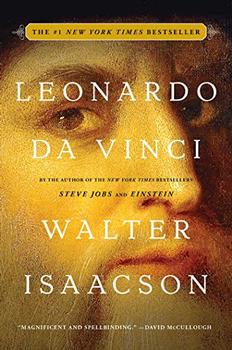Summary | Excerpt | Reviews | Beyond the Book | Readalikes | Genres & Themes | Author Bio

Critics' Opinion:
Readers' Opinion:
First Published:
Oct 2017, 624 pages
Paperback:
Oct 2018, 576 pages
 Book Reviewed by:
Book Reviewed by:
Rose Rankin
Buy This Book
CHILDHOOD MEMORIES
The most vivid memory Leonardo had of his infancy was one he recorded fifty years later, when he was studying the flight of birds. He was writing about a hawk-like bird called a kite, which has a forked tail and elegant long wings that allow it to soar and glide. Observing it with his typical acuity, Leonardo perceived precisely how it opened its wings and then spread and lowered its tail when it landed. This aroused a memory from when he was a baby: "Writing about the kite seems to be my destiny since among the first recollections of my infancy, it seemed to me that, as I was in my cradle, a kite came to me and opened my mouth with its tail and struck me several times with its tail inside my lips." Like much of what came from Leonardo's mind, there was probably some fantasy and fabulism in the brew. It is hard to imagine a bird actually landing in a cradle and prying open a baby's mouth with its tail, and Leonardo appears to acknowledge this by using the phrase "it seemed to me," as if it were perhaps partly a dream.
All of this—a childhood with two mothers, an often absent father, and a dreamlike oral encounter with a flapping tail—would provide great fodder for a Freudian analyst. And it did—from Freud himself. In 1910 Freud used the kite tale as the foundation for a short book, Leonardo da Vinci and a Memory of His Childhood.
Freud got off to a stumbling start by using a poor German translation of Leonardo's note that mistakenly called the bird a vulture rather than a kite. This sent him into a long tangential explanation about the symbolism of vultures in ancient Egypt and the etymological relationship of the words for vulture and mother, all of which was irrelevant and, Freud later admitted, embarrassing. Leaving aside the bird mix-up, the main thrust of Freud's analysis was that the word for tail in many languages, including Italian (coda), is slang for "penis" and that Leonardo's memory was related to his homosexuality. "The situation contained in the fantasy, that a vulture opened the mouth of the child and forcefully belabored it with its tail, corresponds to the idea of fellatio," Freud wrote. Leonardo's repressed desires, he speculated, were channeled into his feverish creativity, but he left many works unfinished because he was inhibited.
These interpretations have prompted some devastating critiques, most famously by art historian Meyer Schapiro, and they seem, at least to me, to reveal more about Freud than about Leonardo. Biographers should be cautious about psychoanalyzing someone who lived five centuries earlier. Leonardo's dreamlike memory may have simply reflected his lifelong interest in the flight of birds, which is how he framed it. And it does not take a Freud to understand that sexual drives can be sublimated into ambition and other passions. Leonardo said so himself. "Intellectual passion drives out sensuality," he wrote in one of his notebooks.
A better source for insight into Leonardo's formative character and motivations is another personal memory he recorded, this one about hiking near Florence. The recollection involved chancing upon a dark cave and pondering whether he should enter. "Having wandered some distance among gloomy rocks, I came to the mouth of a great cavern, in front of which I stood some time, astonished," he recalled. "Bending back and forth, I tried to see whether I could discover anything inside, but the darkness within prevented that. Suddenly there arose in me two contrary emotions, fear and desire—fear of the threatening dark cave, desire to see whether there were any marvelous thing within."
Desire won. His unstoppable curiosity triumphed, and Leonardo went into the cave. There he discovered, embedded in the wall, a fossil whale. "Oh mighty and once-living instrument of nature," he wrote, "your vast strength was to no avail." Some scholars have assumed that he was describing a fantasy hike or riffing on some verses by Seneca. But his notebook page and those surrounding it are filled with descriptions of layers of fossil shells, and many fossilized whale bones have in fact been discovered in Tuscany.
Excerpted from Leonardo da Vinci by Walter Isaacson. Copyright © 2017 by Walter Isaacson. Excerpted by permission of Simon & Schuster. All rights reserved. No part of this excerpt may be reproduced or reprinted without permission in writing from the publisher.





The House on Biscayne Bay
by Chanel Cleeton
As death stalks a gothic mansion in Miami, the lives of two women intertwine as the past and present collide.

The Flower Sisters
by Michelle Collins Anderson
From the new Fannie Flagg of the Ozarks, a richly-woven story of family, forgiveness, and reinvention.

The Funeral Cryer by Wenyan Lu
Debut novelist Wenyan Lu brings us this witty yet profound story about one woman's midlife reawakening in contemporary rural China.
Your guide toexceptional books
BookBrowse seeks out and recommends the best in contemporary fiction and nonfiction—books that not only engage and entertain but also deepen our understanding of ourselves and the world around us.